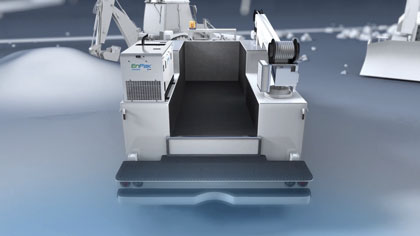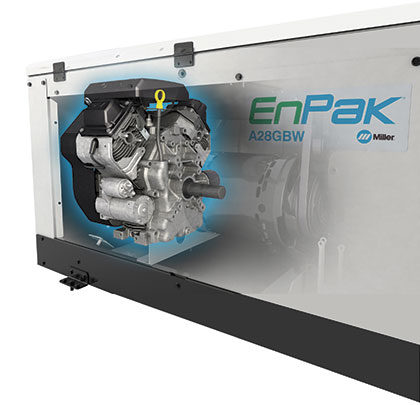The work truck industry has undergone significant changes with the implementation of Tier 4 engine regulations. As a result, some companies have seen an impact on their bottom line—from increased downtime for engine regeneration, to greater fuel costs and more time and money spent on maintenance.
To help address these issues, fleet managers are looking for ways to reduce truck engine idle time (hours). Reducing engine idle hours can save substantial time and money through lower fuel costs, extended truck life, and reduced maintenance and service needs.
Tier 4 engines are not designed to idle constantly. This is a significant challenge for truck fleets because work trucks typically idle all day to power compressors, pumps, hydraulic cranes, and other jobsite tools.
There’s a better option. All-in-one work truck solutions available on the market today allow companies to turn off their work trucks—and still run the tools needed to get the job done efficiently.
A NEED TO REDUCE IDLE TIME
The Environmental Protection Agency’s Tier 4 regulations designed to reduce exhaust emissions typically require the use of diesel particulate filters (DPFs). Excessive idling isn’t good for Tier 4-compliant engines because it causes a buildup of particulates in the filters. As the filters clog, they require more frequent cleaning through a regeneration cycle, which heats and burns off much of the material blocking the filter.
The remaining particulate matter not burned off through the regeneration process can lead to increased regen time, poor fuel economy, reduced power output, and costly engine damage. This remaining material can be cleaned through a specialized process but requires the removal of the DPF from the engine and shipment to a servicing facility. Each DPF can cost thousands of dollars, so any efforts that can help prolong filter life, such as decreasing the engine idle time, can help companies reduce operating costs and downtime.

Today’s Tier 4-compliant truck engines are not designed to idle constantly. However, all-in-one work truck solutions such as the Miller® EnPak® A28GBW allow companies to turn off their work trucks—and still run the jobsite tools needed to get the work done efficiently.
According to Kelly Klemisch, regional truck manager for ARI, not every company has backup trucks or convenient rental options—or perhaps their specs are so unique that backup or rental options don’t exist. In these cases, issues with filter clogging or problems with the emissions controls could shut down an entire crew for hours, days, or even weeks.
Missing or ignoring the regeneration notification can result in very costly downtime, Klemisch says. In addition, when a truck engine shuts down due to a missed regeneration, it may need to be towed to the dealership for maintenance. This impacts how many tools and trucks a company has available to get work done.
Choosing an all-in-one work truck solution, like the Miller® EnPak® A28GBW, allows companies to significantly reduce idle time, as well as the wear and tear on truck engines and service expenses on emissions-control equipment. The EnPak A28 integrated power system allows crews to work with the truck turned off because the unit provides compressed air to power jobsite tools, a generator, battery charge and crank assist, and a stick welder.
A SOLUTION WITH NUMEROUS BENEFITS
Eliminating the need to leave a truck engine running to act as the power source for jobsite tools results in numerous benefits—some related to Tier 4 and some that go beyond that.
Reduced engine wear: Many fleet managers are starting to monitor miles per engine hour. A general rule of thumb in the industry is that one hour of engine idle time is equal to 30 miles on the road. While 30 miles on the road in an urban area is very different than 30 miles on the road in a rural area, the bottom line remains the same: Reducing hours spent idling results in a reduction of total hours on the chassis.
Extended asset life: Reducing the amount of time an engine spends idling helps prolong the life of the truck. After implementing EnPak solutions on its work trucks, one company expected truck chassis life to increase from the typical 7 or 8 years to 10 or 12 years, given the reduction in idle time.

Reduced maintenance and service needs: Less idle time also means that engine maintenance schedules can be extended—saving time and money and reducing the amount of downtime for service.
Lower fuel costs: Investing in an all-in-one work truck solution can help lower fuel costs by allowing fleet managers to turn off the truck. In addition, an all-in-one solution such as the EnPak A28 can take the place of having separate air compressor and welder/generator units, which results in a lighter weight truck. Having a lighter truck can help reduce fuel costs while also providing more available payload space for other tools or parts.
TURN OFF YOUR TRUCK AND REAP THE BENEFITS
Running a work truck continuously on the jobsite to power tools drives up engine idle time, fuel use, engine hours, and maintenance costs. It can be especially expensive with today’s Tier 4-compliant engines, which are not designed for constant idling. Excessive truck idling causes downtime, which impacts efficiency, productivity, and the bottom line.
Reducing engine idling by implementing an all-in-one work truck solution can extend truck life, reduce fuel and maintenance costs, and lower the overall cost of ownership. And, you can keep working even when your work truck is turned off. ■
About the Author: Travis Purgett is a product manager with Miller Electric Mfg. Co. For more information on its all-in-one work truck solutions, visit www.millerwelds.com.
_________________________________________________________________________
Modern Contractor Solutions, May 2017
Did you enjoy this article?
Subscribe to the FREE Digital Edition of Modern Contractor Solutions magazine.

Idle Time


